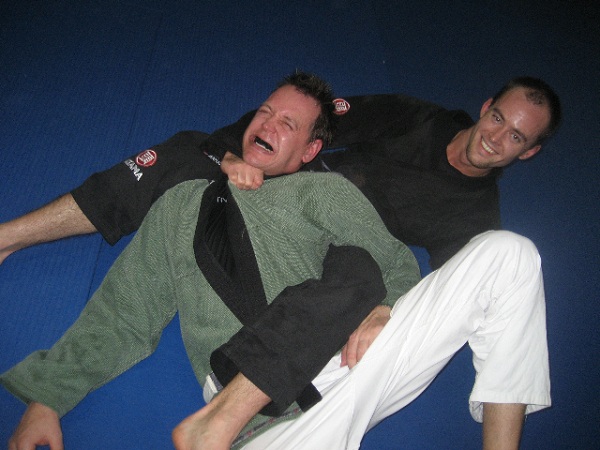My name is Nathan Johnson. Just about one year ago to the day, I strapped myself into my first starchy white Jiu-Jitsu gi. Most of what I’d known about combat I’d learned while watching televised events sponsored by motorcycles and malt liquor. I’m an attorney. A former violinist and high-school debater. A talker, not a fighter. Walking barefoot onto that sweat-marked training space for the first time felt like a moon landing on a hostile, wrestling-mat landscape. The blue flooring of the Minnesota Martial Arts Academy might as well have been a chlorinated depository for the underdeveloped bodies of elementary school divers. To paraphrase famous grappler Vinicius Draculino, the mat was an ocean, and I didn’t know how to swim.
The first weeks of training were academic. I didn’t see it that way then, but I was choreographing moves in the relatively predictable safety of a martial classroom. Those lessons are important, for sure, but you don’t experience the functional realism of Jiu-Jitsu until you sit across from a guy who intends to bring you close to unconsciousness as soon as you touch hands. That’s rolling. It’s the school within the school, where the students engage each other in a real education. You experience different degrees of aggression when you roll, different training partners with different things to prove and different ideas about what you have coming to you. But rolling is what separates Jiu-Jitsu from some of the other disciplines. You prove, every day, that it actually works.
After a month or so of classes, I arrived early, nodded at a relative stranger, and rolled for the first time. I suppose I outweighed him by about thirty pounds. I remember hearing someone yell “Triangle him!” from the periphery of the room as my carotid arteries got synched between the guy’s thighs and my own arm. It happened over and over. I’d try to execute an elementary pass that I learned in class, and I’d get triangle choked again.
During those early days of rolling, I’d come home from the gym, uncap a bottle of Grainbelt Premium, and hang my neck under a hot shower. I looked like a hairless cheetah, my body marked with dozens of finger-point bruises where I’d fought against the grips of my opponents. When you use brute force to counteract superior technique, something has to give. In this case, it was my capillaries. But more noticeably, I felt excruciating pain in my elbows and forearms. I slugged ibuprofen about an hour before class each day so I could endure the stabbing moments between exercises. Eventually, my body adjusted and the pain went away for good, but the bruises kept happening. It’s the spotty uniform of a student who is still fighting to survive.
Four months into training, black belt Ishmael Bentley welcomed me into an advanced class in order to help some of the higher-level students prepare for an approaching Pan-Am competition. After class, I noticed some swelling in my right ear, probably the result of wrenching my head out of guillotine chokes too often. It was a problem for me because it meant that I had the early stages of cauliflower ear, something that wouldn’t go over well at home.
For the next six months, I learned defense, defense, defense, and it became instinctive to glue my elbows in tight to my body, hands ready. I was done pushing them out, begging people to hyperextend my elbows. Now, my hips controlled my movements, because I knew just how vulnerable my arms and neck were. I was the Jiu-Jitsu Protector Guardian variant of the Keirsey Temperament Sorter. But when I competed for the first time, the weakness of my lopsided proficiency showed. I lost six to four, unable to initiate any sort of attack. My points came when I reversed a position, and when I literally fell forward to complete a takedown. Still, I defended well, escaping a number of submission attempts. That’s the benefit of training with tough guys. I’ve never been submitted in competition. So I’ve got that going for me. Which is nice.
During the next few months, my progress surged a bit, something that’s inevitable after you’ve tested yourself for the first time and learned what actually works at full speed. I’m about six-foot-three, and I finally began learning how to use my long, relatively weak legs as weapons. It’s true, technique is the answer when strength is lacking. I’d lost about thirty pounds since my first day at the gym, weighing in at a lanky 181 for my next competition.
So I entered the St. Croix Valley Grappling Games in Hudson, Wisconsin. Three other friends from my Academy competed. One of them, Nora “The Destroyer,” executed a textbook testimonial for the art of Jiu-Jitsu, nimbly beating a male competitor who outweighed her by thirty pounds. My opponents were shorter and stockier than I. They felt strong. The first had a remarkably similar game to my own. I came close to controlling him often, but couldn’t quite transition into scoring position. Our score was tied in the closing minute, and he nearly armbarred me. But I held on and reversed, stealing the winning points by securing a dominant position with just three seconds remaining. I was tired, and my second opponent felt even stronger. I pulled him into my guard and immediately felt like I was straining to hold him there. So I opened my legs, gambling that I’d be able to set up a submission. For over four minutes, I stayed mostly beneath him, my long legs keeping him from passing to a more dominant position. And with twenty seconds left in the match, he tapped to a triangle choke. Technique prevailed in the face of exhaustion.
I had trouble walking after the long submission attempt. I told Japhy Walton, a purple belt from the Academy, that I was prepared to curl up and surrender for second place. But he pointed to my opponent, who was panting on his back in the other room. Somehow, he was more tired than I was, and a quick collar-drag takedown and transition to mount secured my win. I won the gold medal. I’ve rarely been a champion, and when I have figured something out enough to excel, it’s always been in the context of the intellectual rather than the physical. Perhaps that’s why this was the most deeply satisfying victory I have ever experienced.
Alright, I’ve been doing this for a year now. For me, it began with a desire to just understand the sport of Mixed Martial Arts a bit more. And like most things that are surprisingly rewarding in their own rights, it evolved into an obsession. But bruising and competing and losing and winning aside, here is the most important thing. I’m convinced that the sport of Jiu-Jitsu offers the three things that are most important in life aside from food and air: friendship, intellectual development and physical exercise. I’ve sometimes experienced life as a bells-and-whistles neurotic and as a moping depressant. Now, three times a week, I immerse myself in repetitive, five-minute moments where the only thought is survival, and the road to survival requires a quick, adapting progression through mentally-precise physical movements.


